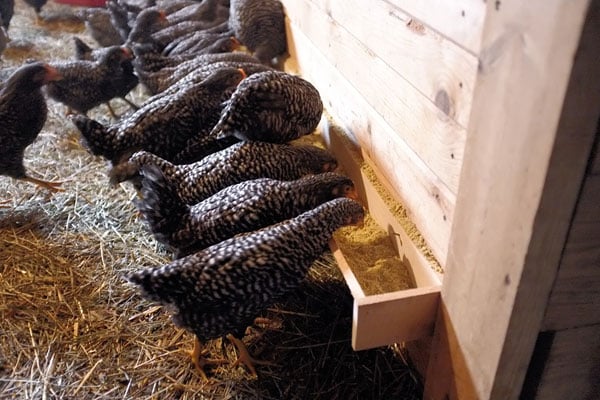Prime
How to calculate the feed conversion ratio

Kuroiler hens feeding from a wooden trough. In Uganda, kuroiler chicken can be breed with indigenous chicken. PHOTO/FILE
What you need to know:
- The feed conversion ratio (FCR) is an important indicator of poultry performance and productivity.
- A high FCR indicates that the bird is converting feed into meat at a high rate, which results in less wasted food and lower costs.
Poultry farming is one of the most common agriculture industries, and it has seen much growth in recent years. This has led to an increase in poultry production, which has put increased pressure on feed resources. Improving the feed conversion ratio (FCR) is critical for poultry farmers who want to increase their income. A few key rules can help you achieve this; by following them, you will be on your way to increased profits.
What is Feed Conversion Ratio?
The feed conversion ratio (FCR) is an important metric to track when growing poultry. It helps farmers determine how many eggs or kilogrammes of meat their birds produce per pound of feed they give them.
However, there are a few key rules to improve your FCR.
To start, you need to ensure that the feed you are providing your birds is high in quality and nutrient-rich. Next, space your feedings throughout the day, so your birds have enough time to digest them.
And finally, make sure that you are providing enough water to your birds during and after their feedings. A feed conversion ratio (FCR) is a key performance indicator used to measure the efficiency of livestock production.
Below are some steps to improve your FCR, but following these key rules will help you achieve the best results:
Cull older birds – The average bird lives for about two years, so cull older birds to reduce the number of feed inputs needed per bird.
Feed high-quality ingredients – Use high-quality feeds specially formulated for poultry to ensure optimal nutrition and improved FCR.
Keep feed levels consistent – Ensure feed levels are consistent across all feeding stations to avoid overfeeding chickens.
Key rules
The first rule is ensuring the feed is of the correct quality. This means that it must be high in protein and energy content, as well as low in calcium and phosphorus.
The second rule is to mix the feed with water properly. This will ensure that the feed is evenly distributed throughout the pen and that each bird has access to enough food.
Increase feed intake
Chickens need around two pounds of food daily to maintain weight. Therefore, feeding chickens more than what they require will result in them overeating and putting on weight unnecessarily. A good way to increase chickens’ feed intake is to increase the amount of grit or ground-up shells included in their diet. This will help them grind down their food and absorb more nutrients. Another way to increase feed intake is to provide them with fresh water daily.
Choose the right feedstuff
The chosen feedstuff should have a low moisture content and be adequate in nutrients and energy. Commercial feeds are available that meet these requirements. A good mix will help to ensure that the feed is being used efficiently and that all the ingredients are being utilized.
Choose the right livestock
Culling sick or unproductive birds can result in a higher FCR because these birds are not eating as much food. Conversely, selecting healthy birds with a high FCR can help keep costs down while providing enough food for growth.
Supplemental feeds
Supplemental feeds can also be incorporated into ration programs to boost FCR. These include brewer’s yeast, algae oil, or fresh green vegetables (like lettuce or spinach). However, supplemental feeds should be used sparingly, as overfeeding can negatively affect poultry health and productivity.
Minimise waste
To achieve optimised performance, waste from poultry production must be minimised. This includes reducing losses due to Feed Injection Facilities (FIFs), minimising pre-chilled offal, and feeding only what is needed for the birds instead of overfeeding them.
Adjust feeding rates
If necessary, adjust feeding rates based on flock size, age, sex, and production goals to achieve the desired FCR. Supplement your bird’s food with minerals and vitamins to ensure it gets all the nutrients needed to grow optimally. Many birds suffer from deficiencies in certain minerals and vitamins when kept on an insufficient ration due to their poor eating or lifestyle habits (such as being confined in a small area). The addition of these essential supplements can help improve FCR.
How to calculate FCR
There are a few key rules that you can follow to improve your poultry feed conversion ratio and reduce feed costs. First and foremost, ensure you are feeding your birds the correct type of feed. For example, feed mixes high in cereal grains should be avoided to increase the FCR. Instead, use feeds with more protein and fiber to help improve digestion and nutrient absorption. Another important aspect of poultry nutrition is water content. Too much water can lead to digestive problems and an increased risk of disease for your birds.
Try to limit freshwater intake to only one cup per day per bird. This will help keep their digestive systems functioning properly.
Feed intake
Chickens need around two pounds of food daily to maintain weight. Therefore, feeding chickens more than what they require will result in them overeating and putting on weight unnecessarily. A good way to increase chickens’ feed intake is to increase the amount of grit or ground-up shells included in their diet.





